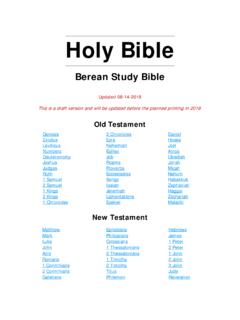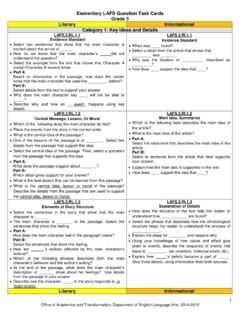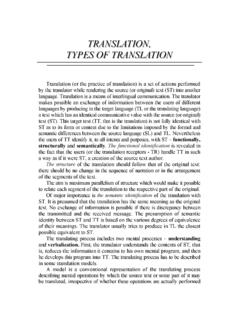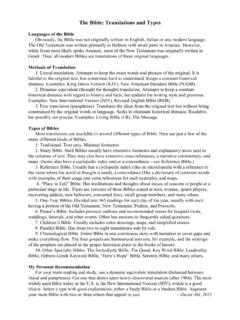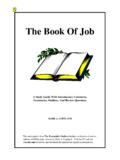Transcription of Klein, William W., Blomberg, Craig L., Hubbard, …
1 1 klein , William W., blomberg , Craig L., hubbard , robert L. Jr. Introduction to Biblical Interpretation. Dallas: Word Publishing, 1993. xxiii + 518 pp. $ cloth. Introduction There are many hurdles to discovering the truth of God s Word, the Bible. The Bible was written by several different authors who lived centuries apart. It was written in three different languages and in many different genres, or forms of literature, each with their own guidelines to proper understanding. Further, a proper interpretation of Scripture is made even more difficult by various cultural issues that cloak the ancient text. In light of these hurdles, it should be easy to understand that gaining an accurate interpretation of the Bible can be a challenging task. So how can one learn what the Bible says? How can its resources be mined? What is the reader to learn and how is he or she to respond? These challenging problems and questions are just some of the issues addressed by a trio of professors from the faculty of Denver Seminary.
2 Dr. William W. klein , Professor of New Testament; Dr. Craig L. blomberg , Associate Professor of New Testament; and Dr. robert L. hubbard , Professor of Old Testament, have combined their years of expertise and devotion to Scripture to provide a concise, logical, and practical Introduction to Biblical Interpretation. Summary klein , blomberg , and hubbard (hereafter referred to as KB and H) offer this volume to advance the practice of Biblical interpretation also called hermeneutics in this generation. A comprehensive yet readable text, it covers all the key issues in 2 1 interpreting the Bible (ixx). The goal, according to KB and H, is to show students not merely what interpretation is all about, but how to interpret (ixx). Admirably, each of the three authors stresses the need to know not only what the Bible says, but also what the Bible means by what it says (xx). In sum the basic goal of this book is to establish, explain, and demonstrate precepts and methods to guide those who want to understand Scripture correctly (5).
3 In so doing, they assist in unraveling some of the mysteries of biblical interpretation (xxi). KB and H divide the book into five main sections. Those five sections deal with topics such as: the task of interpretation, the interpreter and the goal, understanding literature, understanding Bible genres, and the fruits of interpretation. In Part I, KB and H underscore the need to understand the definition of biblical interpretation. Thus, attention is devoted in Chapter 1 to defining hermeneutics and demonstrating the crucial need for careful and valid hermeneutical principles (xxi). The authors appropriately define hermeneutics as the art and science of biblical interpretation. They also address the role of the interpreter and the meaning of the message. KB and H speak to some of the challenges of Bible interpretation, such as: the distance of time (12), cultural distance (14), geographical distance (15), and the distance of language (15).
4 Despite all of these challenges, the authors note that as God s Word to His people, the Bible has eternal relevance (16). At the conclusion of the chapter, the writers affirm that the basic goal of the book is to help readers discover God s message to Christians today from the teachings and stories back then (20). In Chapter 2, KB and H explore the history of interpretation. The authors posit that to understand how to interpret the Bible today requires an appreciation of our 3 predecessors in the Biblical faith (xx). With that philosophy in mind, KB and H review the history of Jewish interpretation, including Rabbinic Judaism, Hellenistic Judaism, and the Qumran Community. They also trace developments in the Apostolic Period, and the Patristic Period, paying particular attention to the apostolic fathers, the contrast between Alexandria and Antioch, and the various church councils. KB and H continue by rehearsing developments during the Middle Ages, the Reformation, and the Post-Reformation period.
5 While assessing the Modern Period, the authors highlight approaches during the nineteenth century, the twentieth century, Post-World War I, and Post-World War II. Throughout this chapter, the goal remains to learn from history appropriating what is valid and valuable while avoiding mistakes and pitfalls (xxi-xxii). The focus of Chapter 3 is the canon and various Bible translations. The authors define the canon of Scripture as the collection of biblical books that Christians accept as uniquely authoritative (53). Within the chapter, KB and H sketch the rise of the canon of the Old Testament, development of the canon of the New Testament, the criteria of canonicity, and the implications for hermeneutics in the discipline of canon criticism (53). Particular attention is also paid to modern critical editions of the Old and New Testaments and the various translations that have been produced. The reader is introduced to the subjects of textual criticism and translation techniques.
6 He is also acquainted with the major English translations and given tips for choosing a translation. Part II is dedicated to familiarizing the reader with the interpreter of Scripture and the goal of proper interpretation. Chapter 4 is dedicated to discussing the qualifications and presuppositions of the interpreter. The authors note that interpreters are not blank slates or empty sponges; who they are contributes greatly to the enterprise of 4 understanding (xxii). Therefore, KB and H discuss the following qualifications of the interpreter: faith, obedience, illumination, and membership in the church which guards against individualism (85). Further, the appropriate methods for interpretation include diligence and commitment, hard work and discipline. Following this, consideration is given to the necessary presuppositions and the nature of preunderstanding. The authors define preunderstanding as what the interpreters bring with them to the task of interpretation (xxii) (however, preunderstanding sounds much like presuppositions ).
7 Having developed the profile of the interpreter, Chapter 5 addresses the goal of interpretation. In this section, KB and H communicate that the goal of interpretation is to discover the message that is already in the text whether consciously or unconsciously intended by the authors or editors (118). To assist in establishing an accurate method of interpretation the writers consider four strategic questions that relate to the meaning of the text: Does the text have one fixed meaning or several levels of meaning? ; Is textual meaning the singular goal of interpretation? ; Can we achieve a legitimate reader-response interpretation? ; and How can we validate our interpretation? The authors contend that these are foundational questions which have enormous implications for the task of interpretation (xxii). Part III is dedicated to establishing accepted principles for understanding how the literary forms of prose and poetry function.
8 The focus of Chapter 6 is the set of general rules for interpreting prose. In order for the intended meaning of any prose passage to be understood, it must be understood within its literary context. The literary context helps to provide the proper flow-of-thought, an accurate meaning of words, and an understanding of correct relationships among units. Further, the writers point out that in order for an 5 interpretation of a biblical passage to be correct, attention must be given to the historical-cultural background, the proper meaning of words, and the grammatical-structural relationships of the passage. KB and H do an acceptable job of explaining the reasons behind and the methods for attending to these details. In Chapter 7, the focus is directed toward general rules for interpreting Old Testament poetry. The authors highlight the fact that poetry is the second most common literary feature in the Bible. They also declare poetry s dynamic to be a language of images that the reader must experience as a series of imagined sensory situations (217).
9 Attention is also given to rhyme and meter (218), the sounds of assonance (221), alliteration (222), and onomatopoeia (224). The structure of Hebrew poetry is also highlighted with emphasis placed upon parallelism (225), chiasm (237), merismus (239), and inclusio (240). In addition to unique structure and sound, biblical poetry also uses distinct language, rich in imagery and poetic device. While these details may appear complicated, the stated goal of the authors is to equip the reader to achieve better understanding. Since languages function according to specific rules and principles, interpreters must understand these rules in order to study the text properly (xxii). While Part III focuses on prose and Old Testament poetry specifically, Part IV is structured to explain Old and New Testament genres in general. Beginning with biblical narrative, Chapter 8 explains the various genres of the Old Testament. Surprisingly, narrative makes up 40 percent of the Old Testament.
10 The various forms of biblical narrative include reports, heroic narratives, prophet stories, comedies (not in the traditional sense but narratives whose plots have happy endings), and farewell speeches. These narratives also include popular proverbs, riddles, fables, parables, songs, 6 and lists. Understanding the distinctives of these narratives is a necessary first step in developing biblical, literary competence (261). The remainder of Chapter 8 is given to defining and directing toward a proper interpretation of the genres of Old Testament Law, poetry (although the topic was previously addressed in Chapter 7), prophecy, and wisdom literature. The stated goal of the chapter is to cultivate in the readers a literary competence the ability to read a text in light of its own background and purpose (322). The definitions and directions given by the authors assist in meeting this goal. In Chapter 9, the writers provide support for understanding the different genres of the New Testament.
